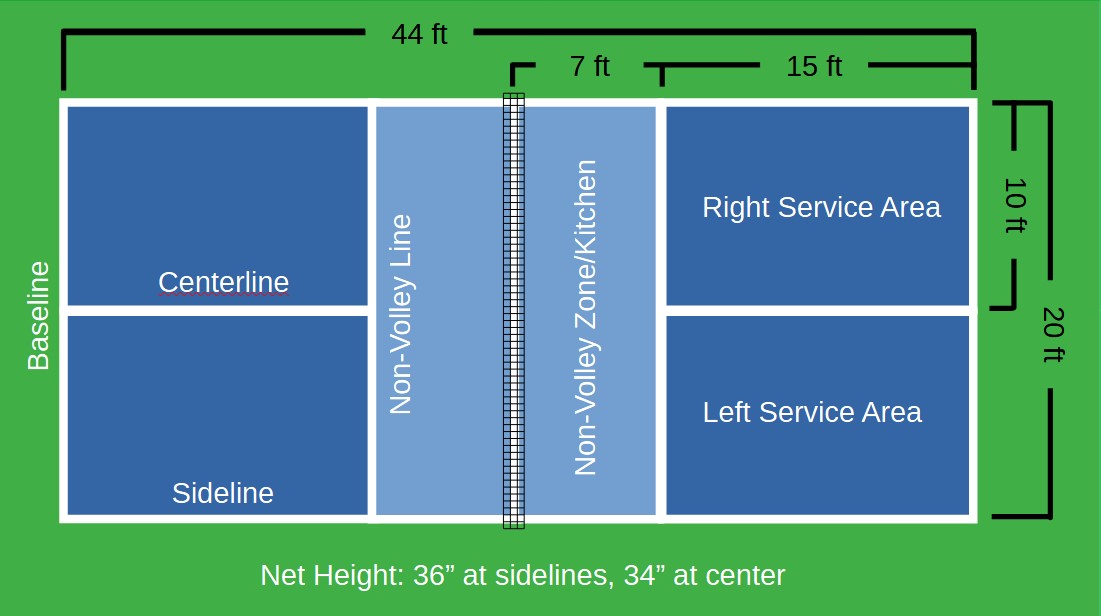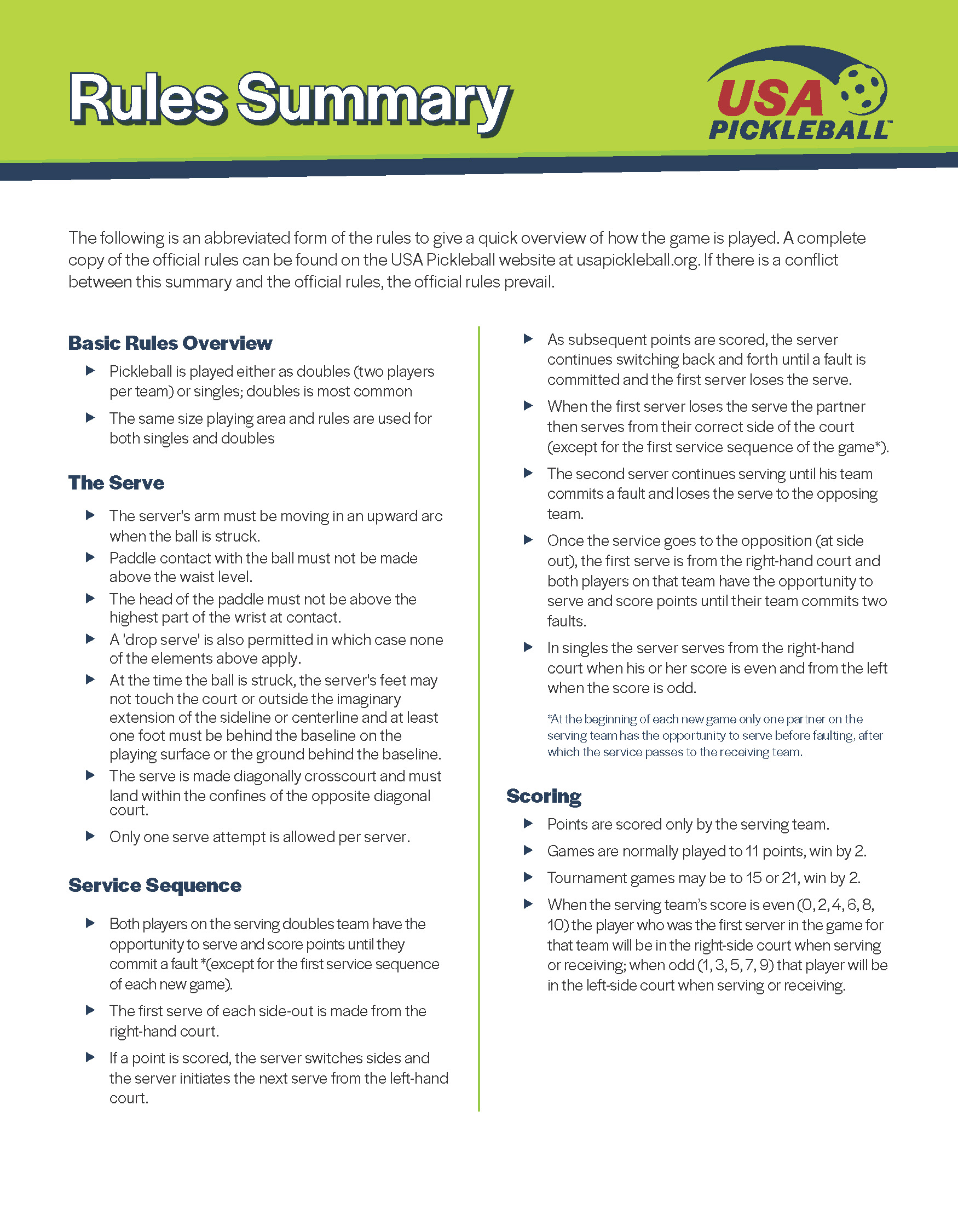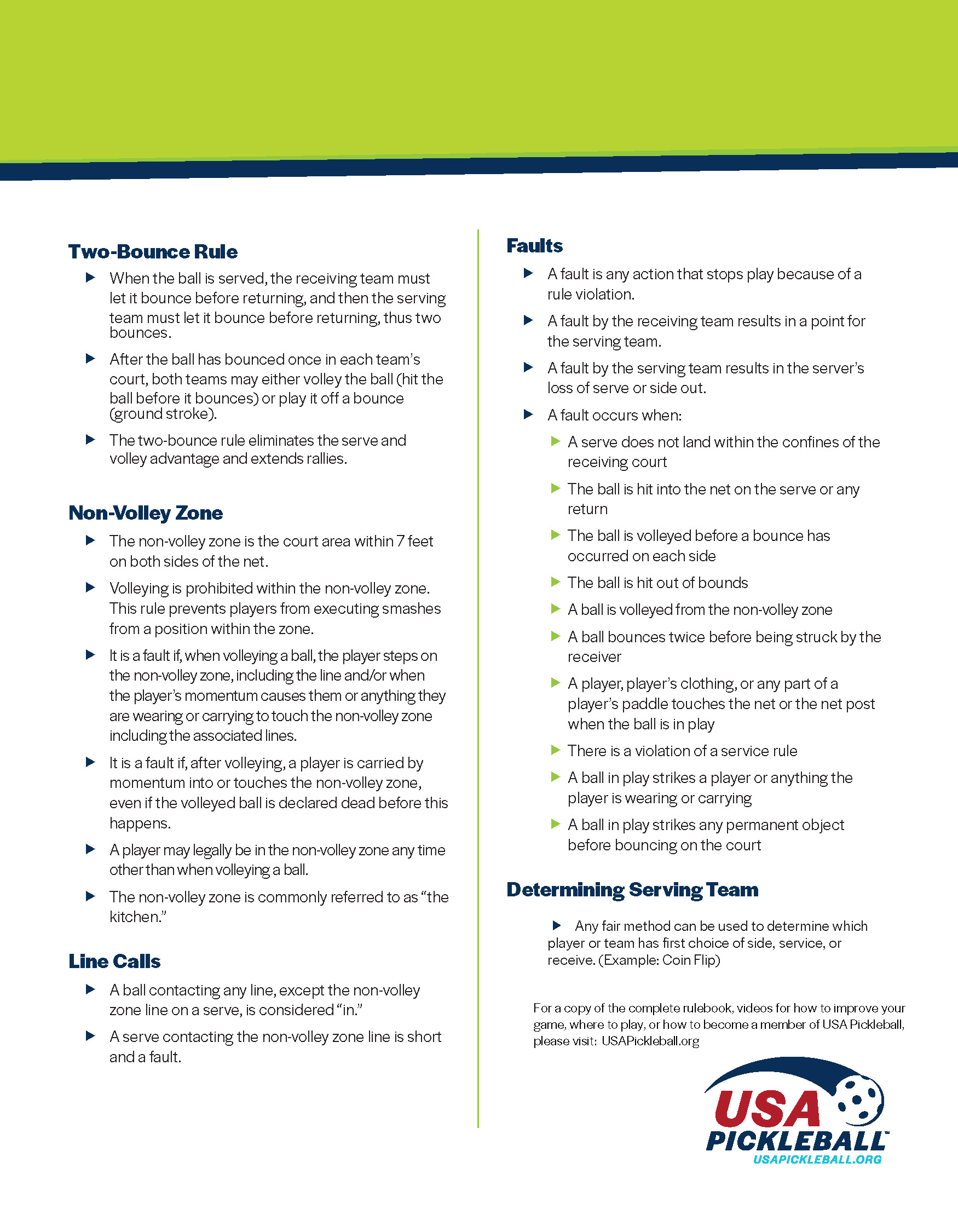Pickleball Rules
The Pickleball Court



January 2025 USAPA 2025 Rule Book
What follows is perhaps sufficient to update you on seven changes you, as a player, are more likely to encounter.
- Those who follow rally scoring, know there is more than one way of playing rally-scoring doubles. After about two years of study, however, USA Pickleball has settled on a format for doubles rally scoring. As most know, a point is scored in each rally for all formats of rally scoring. What makes the USA Pickleball format for doubles rally scoring easy to learn is its simplicity and similarity to side-out scoring. The only differences from what we all know from side-out scoring are:
- Only one server serves at the beginning of a game or after a side-out. Just as in side-out scoring, that server keeps rotating back and forth between the right and left sides of the court with their serve until the receiving team wins a point and gets a side-out. The partner does not serve.
- As a result, only two numbers are called for the score because there is no first or second server.
- The winning point must be made on your serve.
This is a provisional rule; only the second time a rule has been given provisional status. That means it will be in place for a year, and after that, it will be evaluated to either continue as provisional, change, formally adopt, or remove it from play.
- If a tournament player does something aftera match that rises to the level of a Verbal Warning, Technical Warning, or Technical Foul, the Tournament Director can apply that penalty to the offending player’s next match at the tournament. What is the most likely behavior that could result in this occurrence? Someone throws a paddle after the match is over.
- The act of volleying no longer includes the swing of the paddle. Volleying now starts when the player hitting the volley makes contact with the ball. That doesn’t sound very meaningful, but it changes some Non-Volley Zone fault scenarios that were faults in the past but aren’t anymore. Please see Change Document #6 for more details.
- Before 2025, the rule about a particular plane of the net fault was unclear. Recall that you can hit the ball, and your continuation from the shot can legally take you past the net plane. However, the rule was unclear whether your partner could cross the plane of the net on a shot you hit. The rule change clarifies that the continuation provision only applies to the player who hits the ball and is only associated with the current strike of the ball (not one or more shots previously).
- If a team or player either withdraws, retires, or is forfeited during a round robin format, three things now occur:
- If there is no playoff, the match results will not count toward the standings of that round robin.
- If there is a playoff, the match results will not count towards determining which teams advance to the playoff round.
- In both cases above, the match results will, however, count toward the players’ rating.
- Any disagreement between you and your partner about fault calls will be decided to benefit your opponents. This change aligns with the rule about line calls; as most know, any disagreement between you and your partner about a line call is decided to the benefit of your opponents, i.e., the ball is ‘in.’ The same now applies to faults. Oh, and by the way, you are now expected, by rule, to call faults on your partner if, for some reason, they don’t call it on themselves.
- Round-robin tie-breaker procedures return to the method used in 2023 and earlier. This means that if three or more teams are tied in head-to-head results and the tie-breaker method becomes point differential, all teams will be ranked by point differential, and the medal winners or teams advancing to the medal round will be determined according to that ranking.
January 2024 USAPA 2024 Rulebook
Correcting Server, Receiver and Player Position Errors (4.B.9)
Errors in server sequence or receiver position were eliminated.
If a player stops a rally to correct an error, the fault goes to the player who stopped the rally. If the rally has played out, the rally score stands.
Draping Net (2.C.6/11.L.5.b)
This rule applies to temporary nets. When a ball falls on a draped net, the point is replayed.
Catch or Carry Ball on the Paddle (7.L)
Catching a ball or carrying it on the paddle is a fault, whether or not accidental or deliberate.
Conceding a Rally (13.E.4/13.E.5)
The rule pertains to a referee call of a ball as out disputed by player(s). The point should be replayed. Opponents may concede the point if they believe they could not have returned the ball.
Medical Time-Outs (10.B.2.c)
A player using a medical time-out may add available time-outs after the 15 minutes “to allow more time before the player must retire from the match.”
Paddle Specifications (2.E.2/2.E.5.a/2.E.5.c)
See the rules book for paddle specifications.
Mini-Singles (12.O)
Rules for mini-singles are now covered in the rule book.
January 2023 USA Pickleball Rule Book
Correcting Server, Receiver and Player Position Errors (4.B.9)
Incorrect server, receiver, and player position errors are no longer faults. A referee will make the correction before calling the score.
Apparel (2.G.1/2.G.4)
Apparel similar to the color of the ball can be a distraction. A Tournament Director may ask offending players to change apparel in a “non-chargeable time-out.”
Spin Serve (4.A.5)
The server cannot manually add spin to the ball on a serve. Only the paddle can add spin.
Replay or Fault on the Serve (4.A.6/4.A.9)
The referee can stop rally play if the serve is in question. If the serve violates the serve requirements, the referee stops play and calls a fault.
Player Questions about Correct Server, Receiver or Position (4.B.8)
A player may question the correctness of a server, receiver, or player position before the serve. The opponent must respond.
Wrong Score Called (4.K)
Play may be stopped if the wrong score is called. The interruption must occur before the serve is returned. If play is stopped after return of serve, the player stopping play is at fault. Also, a fault occurs when a player stops play to ask for a correction. The question must be asked before the ball is served.
Equipment Time-Out (10.D)
Equipment changes and adjustments do not require use of an “equipment time-out.”
